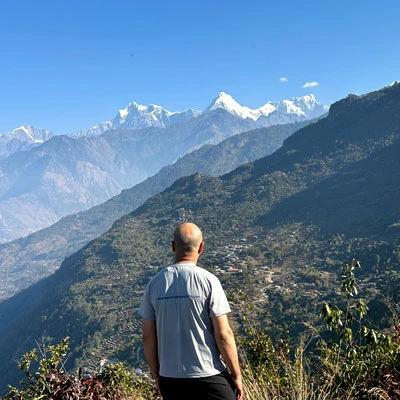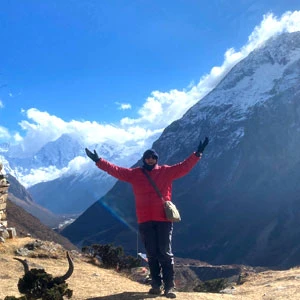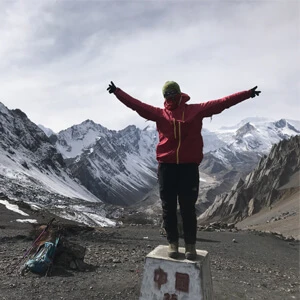Understanding Altitude Sickness
Altitude sickness, often called Acute Mountain Sickness (AMS), is a physical reaction that occurs when your body struggles to adapt to the lower oxygen levels found at high altitudes. As you climb higher altitude, the air becomes thinner, meaning each breath you take delivers far less oxygen than at sea level.
Hence, your body naturally works to compensate due to which your breathing quickens, heart pumps faster, and your body starts producing more red blood cells. Now, if you ascend too quickly without giving your body the chance to adapt, you can develop altitude sickness. It initially starts with mild symptoms, but if ignored, it can quickly escalate into life-threatening conditions.
Altitude sickness comes in three primary forms, each progressively more dangerous.
Acute Mountain Sickness (AMS): It is most common causing headaches, nausea, dizziness, fatigue, and loss of appetite. It’s uncomfortable but manageable if caught early.
High Altitude Pulmonary Edema (HAPE): When you ignore initial symptoms, AMS progresses to HAPE. It is a dangerous condition where fluid accumulates in the lungs, making breathing increasingly difficult even at rest.
High Altitude Cerebral Edema (HACE): It is the most severe case where swelling in the brain leads to confusion, loss of coordination, and ultimately coma or death if untreated.
Why Are You More Prone To AMS During Kanchenjunga Trek?
You face a particularly high risk of altitude sickness during the Kanchenjunga Circuit Trek for several reasons. Initially, the trek itself is one of Nepal’s most remote and challenging journeys with wild, isolated terrain and limited infrastructure. On top of that, access to medical help is extremely limited in the Kanchenjunga region, and emergency evacuation can take days.
Another contributing factor is the limited infrastructure and less commercialization along the Kanchenjunga Circuit. You will only find fewer teahouses and rest stops to pause, recover, or spend extra acclimatization days. Thus, some sections can stretch for long hours between settlements and you will be forced to push further even if you experience mild symptoms.
Lastly, your day on the Kanchenjunga trail consists of long trekking hours with significant elevation gain within a short period, leaving your bodies struggling to adjust. This rapid gain in altitude doesn’t always allow for proper acclimatization, especially if you are on tighter itineraries. Additionally, the colder temperatures along the route further fuels the risk, as cold air dries out the respiratory system faster. It may increase the likelihood of dehydration.
Elevation Profile Of Kanchenjunga Circuit And Risk Zones
Locations | Altitude | Risk Zone | Reasons For Risk |
Taplejung | 1,820 meters | Low | The body is well-acclimatized here, with no immediate risk of altitude sickness. |
Sekathum | 1,660 meters | Low | Ample oxygen and no noticeable symptoms of altitude sickness. |
Lamatar | 2,700 meters | Low | The altitude increases gradually but oxygen levels are still adequate for the body to handle the ascent comfortably. |
Gyabla | 2,950 meters | Low | Very rare to experience symptoms of altitude sickness here. |
Ghunsa | 3,475 meters | Moderate | Body starts adjusting to the thinning air. You may face early symptoms of AMS such as fatigue and headaches without proper acclimatization. |
Khambachen | 4,050 meters | Moderate | The body struggles to adapt, making this a moderate risk zone for AMS. |
Lhonak | 4,780 meters | High | Significant elevation increase, hence, you may be vulnerable to AMS, HAPE, and HACE, especially without acclimatization. |
Pang Pema | 5,143 meters | High | Reduced oxygen levels, AMS symptoms worsen quickly here. |
Sele La Base Camp | 4,480 meters | High | Challenging elevation with high risk for AMS and HAPE. |
Cheram | 3,870 meters | Moderate | Lower altitude than the high passes, but you must be cautious of fatigue and dehydration. AMS may develop if you ascend too quickly or without rest. |
Ramche | 4,580 meters | High | Oxygen levels are low, hence, rapid ascent without acclimatization could lead to AMS or HACE. |
Oktang | 4,730 meters | High | Slightly lower than the North Base Camp but poses risk for AMS. |
New Jhoreni | 2,100 meters | Low | Back to lower elevation, offering a good chance for rest and recovery from the higher altitudes. |
Yamphudin | 2,080 meters | Low | Expect full recovery from the previous higher elevations. |
Birtamod | 1,200 meters | Low | No risk of altitude sickness here. |
Symptoms Of Altitude Sickness
As you ascend to higher altitudes on the Kanchenjunga Circuit Trek, you increase the risk of altitude sickness. Now, this condition will escalate rapidly if you do not manage it properly, so you must understand its symptoms.
Early Symptoms (Often Ignored)
At the onset of altitude sickness, you may experience mild symptoms that are easy to dismiss. Generally, many mistake these initial signs for regular fatigue from the strenuous trekking conditions or the physical demands of the trail.
Headache: It is the first and most common sign of AMS. You may get a persistent headache that doesn’t ease up with hydration.
Loss of Appetite: As the body struggles to adjust to the altitude, your appetite may significantly decrease.
Nausea or Vomiting: You may face it even at the beginning. It makes you want to throw up.
Fatigue and Weakness: Despite not exerting too much physical effort, you may feel unusually tired, drained, and weak.
Dizziness or Lightheadedness: TYou may feel dizzy or lightheaded, especially when standing or moving around.
Difficulty Sleeping (Insomnia): The lack of oxygen at higher altitudes can make it harder to sleep, you may feel restlessness during the night.
These early symptoms indicate that the body is struggling to acclimatize.
Moderate Symptoms (Warning Signs)
If you ignore the initial symptoms, altitude sickness progresses and may become more pronounced. These moderate symptoms serve as warning signs that the body is experiencing greater difficulty in adapting to the altitude.
Severe Headaches: At this stage, you may have intense headaches that are unresponsive to common painkillers.
Increased Nausea and Vomiting: Your nausea and vomiting can worsen and you may not be able to hold your food or liquid.
Shortness of Breath at Rest: Even without any physical exertion, you may find it difficult to breathe.
Persistent Dizziness: You may have constant dizziness which causes difficulties in maintaining balance or coordination.
Swelling of Hands, Feet, or Face: Your hands, feet, and face may start to have extreme swelling.
At this stage,you must be cautious and consider descending to a lower altitude to help alleviate the symptoms.
Severe Symptoms (Potentially HAPE or HACE)
If altitude sickness continues without intervention, it can escalate into life-threatening conditions such as HAPE (High Altitude Pulmonary Edema) or HACE (High Altitude Cerebral Edema). These severe symptoms are a clear indication that your health is at risk and you need to take an immediate action.
Confusion or Difficulty Walking: This can occur due to a lack of oxygen reaching the brain. You may face cognitive impairment and difficulty walking without assistance.
Breathlessness Even When Resting: Shortness of breath becomes extreme, even without physical exertion, and can signal HAPE.
Persistent Chest Congestion: You may feel a deep, persistent cough and chest tightness which indicates HAPE. You may also cough up frothy or bloody sputum.
Hallucinations, Irrational Behavior, or Severe Lethargy: These symptoms point to HACE. It occurs when the brain is starved of oxygen, leading to confusion, irrational behavior, and extreme fatigue.
Loss of Coordination (Ataxia): Ataxia is a lack of muscle coordination. Due to it, you will face difficulty while walking or moving without assistance. This is another sign of HACE.
Blue or Gray Lips and Fingernails: It is an emergency situation when the skin and nails may take on a bluish or grayish hue, indicating a severe lack of oxygen in the blood.
Such severe symptoms can be life-threatening. Therefore, you will need to make an immediate action such as descending to a lower altitude.
Common Risk Factors Of Altitude Sickness
Altitude sickness doesn’t affect everyone equally. In fact, some are naturally more prone to it than others due to individual health, previous experiences, and how their body reacts to high altitude. However, there are several common risk factors that significantly increase the chances of developing Acute Mountain Sickness (AMS) or more severe forms like HAPE and HACE.
Past history of AMS (Acute Mountain Sickness): If you have experienced altitude sickness on previous treks, you are more likely to develop it again.
Pre-existing medical conditions: If you face respiratory issues (asthma, COPD), cardiovascular diseases, and other chronic health conditions, you may be more vulnerable to altitude sickness.
Rapid ascent: Ascending too quickly without allowing your body enough time to acclimatize will trigger the symptoms.
Skipping acclimatization days: If you rush the itinerary and skip rest days, your body will not get enough time to adapt to the oxygen levels and hence, face the issue.
Dehydration: Inadequate fluid intake, combined with cold, dry air, speeds up dehydration, which worsens altitude sickness symptoms.
Poor nutrition: Not eating enough or maintaining a balanced diet can weaken your body’s ability to cope with high altitude stress.
Alcohol consumption and smoking: Both alcohol and smoking impair oxygen delivery to the body.
Inadequate physical preparation: If you do not have good physical condition or if you haven’t trained for high-altitude, you are more exposed to altitude sickness.
Overconfidence and ignoring early symptoms: If you push forward despite mild symptoms, it can quickly lead to severe illness.
Prevention Strategies For Altitude Sickness In Kanchenjunga Circuit Trek
To prevent altitude sickness, you will need to plan smart, listen to your body, and respect the mountains. Here, you will need to follow simple strategies like gradual ascent, proper hydration, balanced nutrition, and sufficient acclimatization.
Acclimatize Properly
The Kanchenjunga Circuit Trek takes you into extremely high-altitude regions, where the air gets thinner with every step. You should spend extra nights at key locations like Ghunsa (3,595 meters) and Lhonak (4,780 meters). These acclimatization stops provide you much-needed rest as well as allow your body the chance to gradually adapt to the lower oxygen levels.
Follow The Acclimatization Principles
One of the most effective ways to prevent altitude sickness is to ascend gradually. The golden rule is to climb high, sleep low whenever possible. This means you can hike to a higher altitude during the day, but you should return to a lower elevation to sleep. This process allows your body to experience the thinner air without overwhelming it.
Stay Hydrated
Dehydration is a silent contributor to altitude sickness, especially on long treks like Kanchenjunga Circuit. During the journey, the cold mountain air will dehydrate you faster than you realize. Therefore, you should aim to drink at least 3 to 4 liters of water daily, even if you don’t feel particularly thirsty. To drink more water, you can also add electrolytes to help maintain your body’s fluid balance.
Eat Carb-Rich Meals
At higher altitudes, your body burns more calories than usual. To keep your energy levels up and support acclimatization, you must eat carbohydrate-rich meals. For instance, Dal Bhat, soups, noodles, and rice-based dishes are perfect as they provide quick energy while being easy to digest.
Listen To Your Body
If you ignore the early signs of altitude sickness, it can quickly lead to serious complications. You should tune into how you are feeling at all times. Even a mild headache, loss of appetite, or unusual fatigue could be an early warning sign. Later, if symptoms persist or worsen, it’s crucial to descend immediately rather than push forward.
Consider Preventive Medications
You can even choose to take preventive medication, such as Diamox (Acetazolamide), to help your bodies acclimatize more efficiently. Diamox works by encouraging deeper breathing, which improves oxygen intake at altitude. However, this medication may not be suitable for everyone, and it’s essential to consult your doctor before the trek to see if it’s right for you.
Trek With Experienced Local Guide
The Kanchenjunga Circuit is one of Nepal’s most remote treks, with fewer villages, limited infrastructure, and challenging terrain. To navigate its difficult trails, you will need to hire an experienced local guide. They will help you with both navigation and monitoring your health. A knowledgeable guide can spot early signs of altitude sickness, make quick decisions about pace and rest days, and arrange emergency evacuation if necessary.
Buy Proper Travel Insurance
Comprehensive travel insurance is non-negotiable for the Kanchenjunga trek. You must ensure your insurance covers high-altitude trekking and includes helicopter evacuation. Additionally, you must also confirm your coverage and payment of all medical bills if needed before you arrive in Nepal.
Conclusion
The Kanchenjunga Circuit Trek offers a rare chance to explore one of Nepal’s most breathtaking and untouched trekking routes. Meanwhile, it also carries a challenge of extreme altitudes that can directly affect your health. Therefore, proper preparation in understanding altitude sickness symptoms, and respecting your body’s limits are all essential for a safe and successful trek.
Remember, altitude sickness doesn’t discriminate. It can affect anyone, regardless of fitness level or trekking experience. That’s why partnering with Nepal Trekking Experts can make all the difference. With highly experienced guides certified in wilderness first aid, personalized itineraries designed for proper acclimatization, and top-notch service from start to finish, NTE prioritises your safety and comfort along the trek.
FAQs
What is the maximum elevation level of the Kanchenjunga Circuit Trek?
The maximum elevation level of the Kanchenjunga Circuit Trek is at 5,143 meters / 16,873 feet at the Kanchenjunga Base Camp.
At what altitude does altitude sickness become a risk on this trek?
Symptoms can start as low as 2,500 meters, but risk significantly increases above 3,500 meters, especially after Ghunsa, Lhonak, and the North and South Base Camps.
What are the common early symptoms of altitude sickness?
Headache, nausea, dizziness, fatigue, loss of appetite, and difficulty sleeping are typical early signs.
How can I prevent altitude sickness on the Kanchenjunga trek?
Acclimatize properly, ascend slowly, stay hydrated, eat well, and listen to your body. You can even choose to take preventive medication like Diamox.
Is altitude sickness related to fitness level?
No. Even the fittest trekkers can experience altitude sickness if they ascend too quickly or fail to acclimatize properly.
Are there medical facilities along the Kanchenjunga Circuit?
Very limited. As a matter of fact, there are no large health posts, and evacuation by helicopter may be the only option in severe cases during the Kanchenjunga Trek.
Why is hiring a guide important for managing altitude sickness?
Experienced guides can recognize symptoms early, advice on proper acclimatization, and coordinate emergency evacuations if needed.







